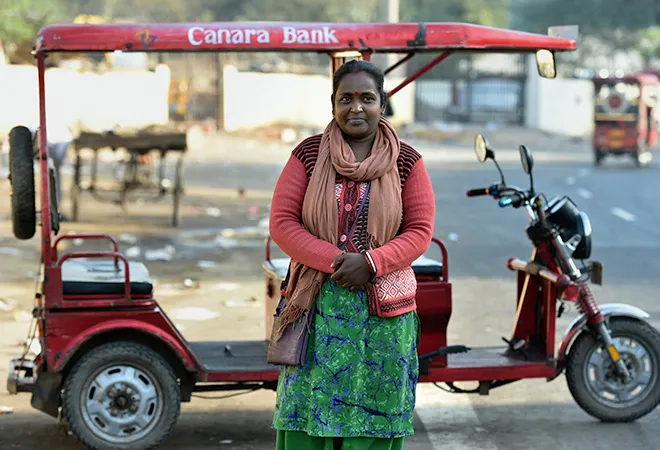-
CENTRES
Progammes & Centres
Location
India’s job challenges is about more than creating enough jobs.

Image Source: © Press Trust of India
Binota, Delhi’s first female e-rickshaw driver in front of her vehicle.
India’s job challenge extends far beyond creating a sufficient number of new jobs, of which India needs an overwhelming 8.4 million every year. <1> To make jobs work for India, it is necessary to generate employment opportunities that provide needed wages, security and protections; to bring previously excluded individuals into the paid economy; to manage the risks of increasing wage and skill divides; to prepare the workforce with needed skills and capabilities; and increasingly, to provide India’s aspiring population with purpose.
Job creation in India will be defined by the ability of India’s companies and rising entrepreneurs to generate employment opportunities. This will require balancing both an attractive business environment, with meeting the needs of India’s workforce. While India has seen improvements in its performance on the World Bank’s Ease of Doing Business rankings, major hurdles remain.
Job creation in India will be defined by the ability of India’s companies and rising entrepreneurs to generate employment opportunities.
At the same time, the highly informal and micro nature of India’s economy means that most workers are not employed in firms that are required by law to provide basic wages, protections and security. Further, the trend towards non-standard forms of employment such as gig-based, freelance, and part-time work requires new models of social security beyond employer-provided and premise-based provision.
There must also be a balanced approach to the dual challenge of creating enough jobs, and the economic, social and moral imperative of brining more people into the workforce. For instance, women are vastly under-represented in the labour market, with a female labour force participation rate of just 27 percent. <2> Not only is this one of the lowest rates in the world, it has also declined by 11.4 percentage points between 1993 and 2011. <3> The perception that there are insufficient jobs in India often perpetuates the idea that those few job opportunities should go to men. Increasing women’s participation to the same rate as men’s, would make India 27 percent richer, and more fair. <4>
Technological advancement, such as smart manufacturing, not only poses the risk of job displacement, it may also lead to a greater divide in wages and skills. As observed in the United States and Europe, the adoption of new technologies often leads to a hollowing out of skill demand in the middle of the distribution resulting in greater wage inequality. <5> Such tendencies can already be seen in India’s organised manufacturing sector. <6> The introduction of digital technologies requires workers with different skill sets. This change in demand means that individuals need to be able to skill, re-skill and upskill, not once, but throughout their lives. India will have to leverage the opportunities presented by advanced technologies and digitisation, while managing the risks of increasing inequality.
The trend towards non-standard forms of employment such as gig-based, freelance, and part-time work requires new models of social security beyond employer-provided and premise-based provision.
Finally, an often overlooked dynamic of this challenge is that employment provides more than just wages, security and protection — it provides purpose. India does not only need to create enough jobs for India’s bulging youth population, with 1.3 million young people reaching a working age every month. <7> India also needs to create jobs which meet the aspirations and desire for upward mobility of India’s young, as the risks of failing to do so are immense. <8>
A number of questions remain for India moving forward:
<1> World Bank, 2017, “Jobless Growth,” South Asia Economic Focus (April): 30. Doi: 10.1596/978-1-4648-1284-2
<2> Luis A. Andres, Basab Dasgupta, George Joseph, Vinoj Abraham and Maria Correia, “Precarious Drop: Reasessing Patterns of Female Labour Force Participation in India,” World Bank Group. (April 2017): 2.
<3> Luis A. Andres, Basab Dasgupta, George Joseph, Vinoj Abraham and Maria Correia, “Precarious Drop: Reasessing Patterns of Female Labour Force Participation in India,” World Bank Group. (April 2017). 4.
<4> IMF Staff Discussion Note, “Women, Work and the Economy: Macroeconomic Gains from Gender Equity,” 2013.
<5> For Example: David H. Autor and David Dorn, “The Growth of Low-Skill Service Jobs and the Polarization of the US Labour Market,” American Economic Review, 103 no. 5 (2013): 1553-1597.
<6> Radhicka Kapoor, “Technology, Jobs and Inequality: Evidence from India’s manufacturing Sector,” ICRIER Working Paper no. 313. (February 2016). And, Pankaj Vashisht, “Destruction or Polarization: Estimating the Impact of Technology on Jobs in Indian Manufacturing,” ICRIER Working Paper no. 334 (March 2017).
<7> World Bank, 2017, “Jobless Growth,” South Asia Economic Focus (April): 30. Doi: 10.1596/978-1-4648-1284-2
<8> Samir Saran and Akhil Deho, “Globalization, Demography, Technology, and New Political Anxieties,” Raisina Files: Debating Disruption in the World Order. vol 3 (January 2018): 32-41.
The views expressed above belong to the author(s). ORF research and analyses now available on Telegram! Click here to access our curated content — blogs, longforms and interviews.